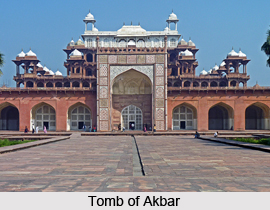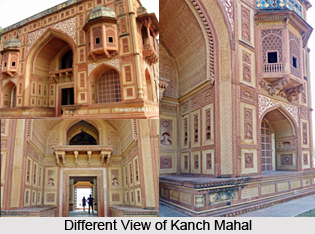 Sikandra is a town in the state of Uttar Pradesh. It lies 9 km along the road to Mathura and the Mausoleum of Akbar. This town takes its name from Sikander Lodi (1489-1517), one of the last kings of the Delhi Sultanate`s. A number of ancient pillars and several tombs can be seen at this town. There is a sculptured horse 4 miles from Agra alleged to commemorate one of Akbar`s favourite animals which died nearby. Opposite is the Kachi-ki-Sarai, approached via an ancient arched gateway. About 800 m beyond is the Guru Ka Tal, a large red sandstone tank marked by octagonal towers.
Sikandra is a town in the state of Uttar Pradesh. It lies 9 km along the road to Mathura and the Mausoleum of Akbar. This town takes its name from Sikander Lodi (1489-1517), one of the last kings of the Delhi Sultanate`s. A number of ancient pillars and several tombs can be seen at this town. There is a sculptured horse 4 miles from Agra alleged to commemorate one of Akbar`s favourite animals which died nearby. Opposite is the Kachi-ki-Sarai, approached via an ancient arched gateway. About 800 m beyond is the Guru Ka Tal, a large red sandstone tank marked by octagonal towers.
The `Mausoleum of Akbar` lies at the centre of a big garden, which is surrounded by high walls stabbed on each side by four 70 feet doorways constructed of red sandstone and marble mosaics. Crowning each corner of the gateway are four marble minarets, they are each of three storeys, in the centre there is a lofty pointed arch flanked by several smaller arches on each side. It is a perfectly symmetrical composition. A wide sandstone walkway leads to the mausoleum. It was built on a low marble platform, above which rises an orderly arrangement of red sandstone pavilions in three tiers, covering which is an open court surrounded by a marble screen. The ground storey includes a superb composition of arched recesses. In the centre, there is a tall, rectangular gateway with a recessed niche, above which rises a stylish and very graceful marble kiosk in silhouette on the skyline.  The burial chamber is reached by a passage that leads deep into the centre of the building. The domed ceiling of the crypt carries ornamental frescoes in blue and gold. Akbar`s grave is plain and devoid of any inscription. Flanking the main vault, a number of bays are enclosed and consist of several family tombs with beautiful inscriptions.
The burial chamber is reached by a passage that leads deep into the centre of the building. The domed ceiling of the crypt carries ornamental frescoes in blue and gold. Akbar`s grave is plain and devoid of any inscription. Flanking the main vault, a number of bays are enclosed and consist of several family tombs with beautiful inscriptions.
Above the first tier, there is a large platform, over which rises the rest of the building. The second storey of red sandstone is punctuated with highly decorated kiosks and marble domes of Hindu design. The third and fourth storeys are also similar, but the top storey includes only tall marble screens of varied designs. Each screen has 36 arches, each divided into panels carrying Persian acclamations. In the centre lies a replica gravestone directly over the actual grave in the lower chamber. It is carved from a single block of marble with delicately chased flowery patterns and 99 names of Allah. About 4 feet away is a small marble base, which was once covered in gold. The mausoleum was one of the most striving building projects undertaken by the Mughals. Just to the east of the tomb is the `Kanch Mahal`, an exceptional and fine instance of Mughal domestic architecture. It was built for Jahangir. It was highly detailed with inlaid stone and patterned tiles. One more important monument of Sikandra is Mariam Zamani`s Tomb.
Monuments of Sikandra are aptly defined as the reminiscences of the broad Mughal era and Akbar`s reign.



















